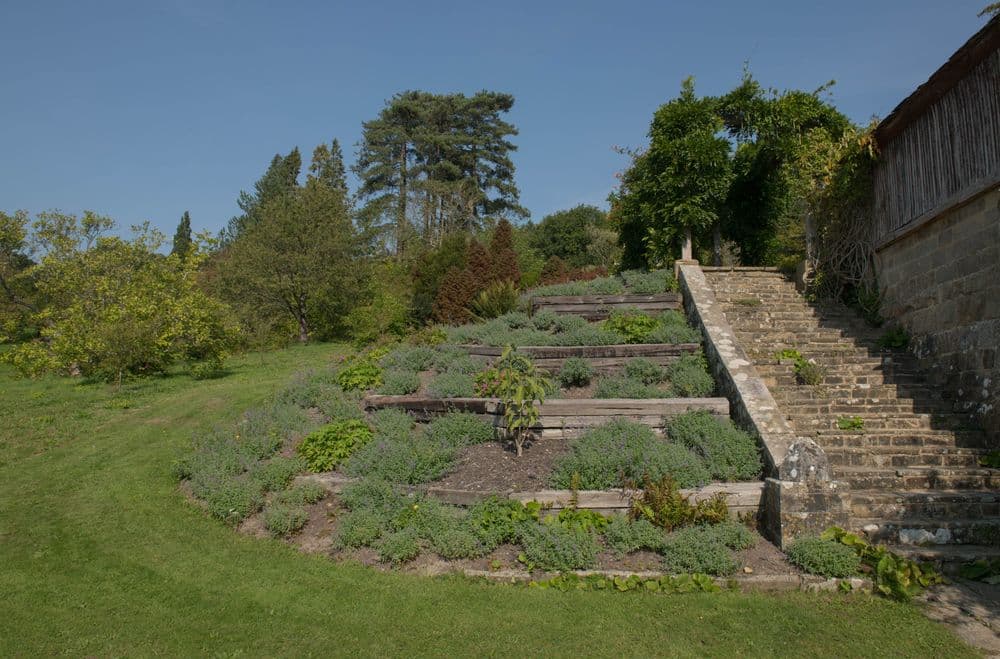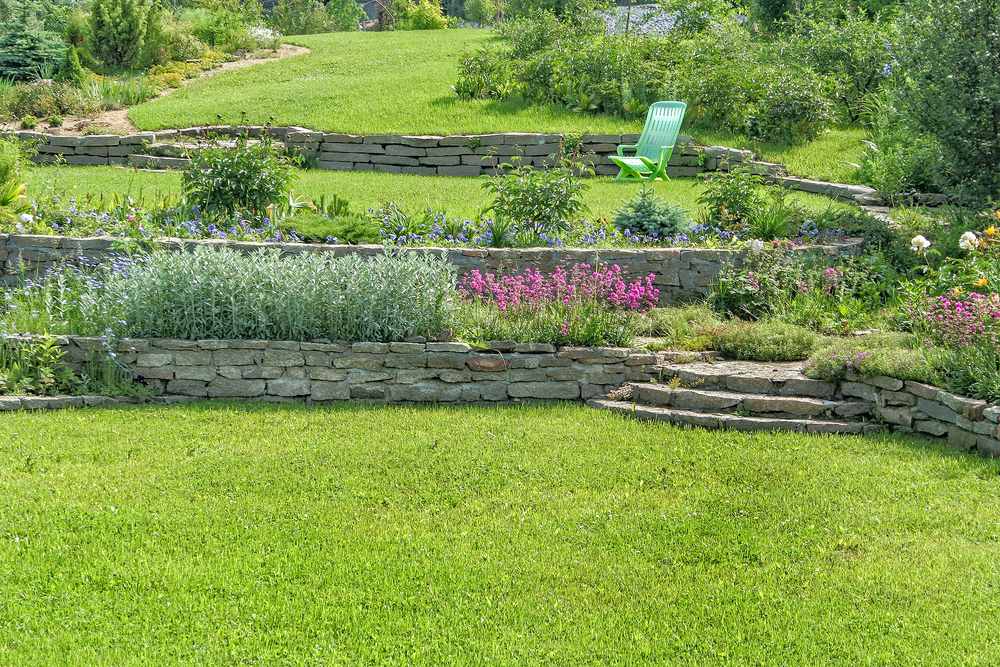
Most people would love a beautiful garden, but the challenge of hillside landscaping on a slope can be daunting. A steep slope can make it difficult to find level ground for planting and can lead to soil erosion if not adequately addressed.
With creativity and hard work, you can turn your sloped property into a stunning garden oasis. Here’s what you need to consider for hillside landscaping on a slope and some tried and true hillside landscaping ideas to get you started.
What to Consider for Hillside Landscaping Ideas
Hillside landscaping presents unique challenges to consider. Before you start picking out plants or making plans, make sure you give each of the following aspects some thought so you can learn how to landscape a hill:
Professional Participation
If you’re unsure how to landscape a hill or need additional help, consider hiring a professional landscape designer or contractor like us. We can guarantee that your slope is stable and suggest plants and materials best suited for landscaping on a slope.
Slope
Evaluate the angle of your slope to determine what type of retaining wall and terracing you need for maximum stability. First, a general evaluation is helpful. Is it slight, medium, or steep?
A slight grade may only need a few rocks and strategically placed plants to help control the soil, while a medium grade may require additional stabilization through landscape fabric. Steep hill landscaping ideas on a slope would require more extensive terracing and a robust retaining wall system to reduce the risk of soil erosion and landslides.
Then, to find the percent of slope and angle of slope, just plug a few measurements into a simple equation and you’ll be able to better envision your design.
Soil
After evaluating your slope angle, consider what type of soil you have on your property before coming up with more hillside landscaping ideas. Is your soil unstable like sand, or more sturdy like clay? Is there a thin layer of topsoil on top of the rock, or is there a deep, secure subsoil layer?
Drainage
Evaluate where water will go once it hits. Where does it flow after it passes your steep hill landscaping? When you know how water flows along your property, you can adjust your plan accordingly. Make sure an adequate system for drainage is part of your design to prevent unnecessary erosion and minimize the chances of collapsing soil.
Access
If you want to use your hillside landscaping for functional purposes or maintenance, consider how you’ll access it. If it’s real steep hill landscaping, you may need to install stairs or pathways made from natural stone, concrete blocks, or pavers so you can easily move up and down the slope.
Hillside Landscaping Ideas for Sloped Property

Ready to change your hillside into a garden or landscaped beauty but don’t know where to begin? Start with these hillside garden ideas that are known to work well with sloped land to support the soil and keep your hard work intact.
Install a Retaining Wall
A retaining wall is a great way to create level areas on your hillside landscaping while keeping the soil in place. Have you thought about adding one?
Ideally, you want to place the retaining wall at the base of the slope and fill the area behind it with soil to create a flat space. A retaining wall can be made of many different materials, such as stones, pavers, or concrete blocks, and is a great way to give your hillside shape and control soil erosion.
Another idea is to create several retaining walls if you have a steeply sloped property. Build your walls with a few feet between them, and then pack in additional soil to create a stepped effect that will help retain your soil and plants.
Add Terraces and Staircases
Terraces and staircases made from natural stone or concrete blocks will make it easy to access the higher areas. They’re great components to add to your hillside landscaping ideas. Well-placed steps can also reduce erosion while adding to your slope’s stability.
When creating terraces, make sure they are wide enough to add plants and wide enough to be stable. You can also use different materials, such as bricks, stone, or gravel to create visual interest.
When building staircases, consider adding an arm rail if possible or if stability is a concern for you or others who live with you. Another tip to ensure safety on the stairs or terraces is to mark the flat areas so no one missteps and takes a tumble.
Create Raised Beds with Retaining Walls
Raised beds are a great way to create level areas for planting without disturbing the soil on your slope. If raised beds are one of your hillside landscaping ideas, construct a rectangular-shaped retaining wall around the area you want to fill with soil.
Some plants that do well in raised beds include fruits, vegetables, perennials, flowers, or a mix! Another great idea is to plant items that bloom in different seasons which will ensure you always have something growing all year round.
Plant Drought-Resistant Plants and Trees
When choosing plants for your design, pick those that are right for your climate. If you live in an area with high temperatures and low rainfall, opt for drought-resistant plants or trees. These plants will be able to survive the heat while still thriving in the sun. Some popular drought-resistant choices include succulents, cacti, aloe, lavender, and other low-maintenance plants.
Use Decorative Accents to Add Interest
Adding decorative accents to your hillside landscaping idea is a great way to spruce up the area and make it more interesting. Use rocks, gravel, or pavers to create pathways or accentuate borders. You can also use these same materials in flower beds for a unique look.
Add Outdoor Lighting
Get creative with outdoor lighting fixtures to enjoy your garden at night. Install pathway lights or solar-powered spotlights to highlight special features in your garden. Additionally, placing lights near pathways will make it easier for you to move around safely after dark.
Calling in Help
Of course, it is always a good idea to seek the advice of an experienced designer or contractor like those at Architecture Landscape Design to ensure that your slope is stable and that the plants you choose will thrive in your climate.
Get any necessary permits and follow local building codes if you’re doing any structural hillside landscaping work on your property.
If the paperwork feels overwhelming, call a landscaper at Architecture Landscape Design who can help with the technical aspects of the project just as much as the creative and execution. With the right planning and care, you can create a beautiful landscape that will be enjoyed for years to come!
Tips to Maintain Hillside Landscaping
Beyond learning how to landscape a hill, you also need to know how to care for your hillside landscaping idea. Hint: regular maintenance is key to keeping it looking great.
Constant Supervision
Regular supervision is something many people forget when creating their hillside landscaping ideas. Check for signs of erosion and if necessary, add additional topsoil or gravel to fill in any dips or holes. Keep an eye out for weeds and be sure to remove them promptly so they don’t take over.
Regular Pruning and Watering
Prune back trees and shrubs to keep them looking neat. If you have any plants that require frequent watering, such as vegetable gardens or flowers, make sure these are watered regularly. Keep the need for pruning and watering in mind when coming up with hillside garden ideas.
Use Quality Soil
Use quality soil and fertilizer to ensure that your plants have the nutrients they need. If it isn’t part of your hillside landscaping idea yet, invest in organic fertilizers to provide your plants with the best possible nutrition. Using better materials will equate to less work for you.
Choose Easygoing Plants
Looking for hillside garden ideas to save you time? Choosing plants that are low-maintenance and easy to care for to save time and energy is always a smart hillside landscaping idea.
Install Irrigation
Install an irrigation system to make landscaping on a slope and watering your plants easier. An irrigation system allows you to enjoy your landscape without having to worry about hand-watering every day.
Add Mulch
Adding mulch to your garden conserves moisture, prevents weeds, and improves soil structure. Spread it around plants to keep them healthy and happy and minimize the maintenance work required by your hillside landscaping ideas.
Use Durable Materials
Use materials that are weather-resistant and durable to ensure your hillside landscaping ideas stand the test of time. Materials like concrete, stone, and brick will last longer for your hillside garden ideas with less maintenance than wood or plastic.
The Hillside Gardner’s Guide to Great Landscapes

Creating beautiful hillside landscaping ideas is no easy task. With the right hillside garden ideas and maintenance, however, you can transform your property into an oasis of beauty and tranquility with steep hill landscaping.
Follow these tips to create a hillside landscaping design that is both beautiful and functional and will last for many years to come. Need help learning how to landscape a hill? Contact ALD today to get started.
